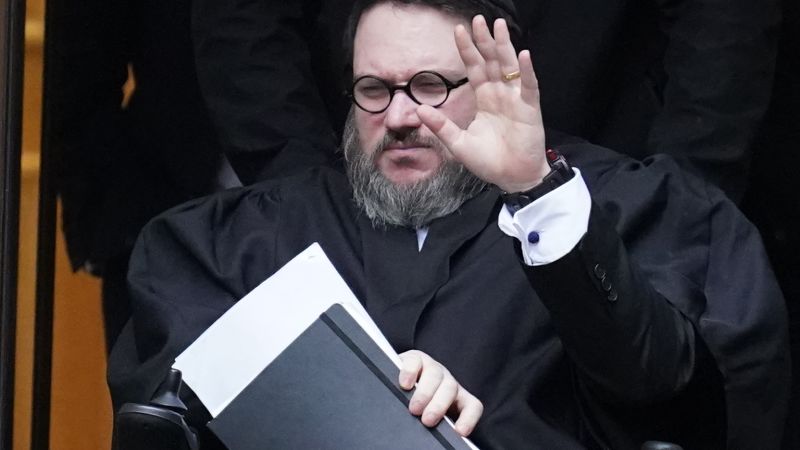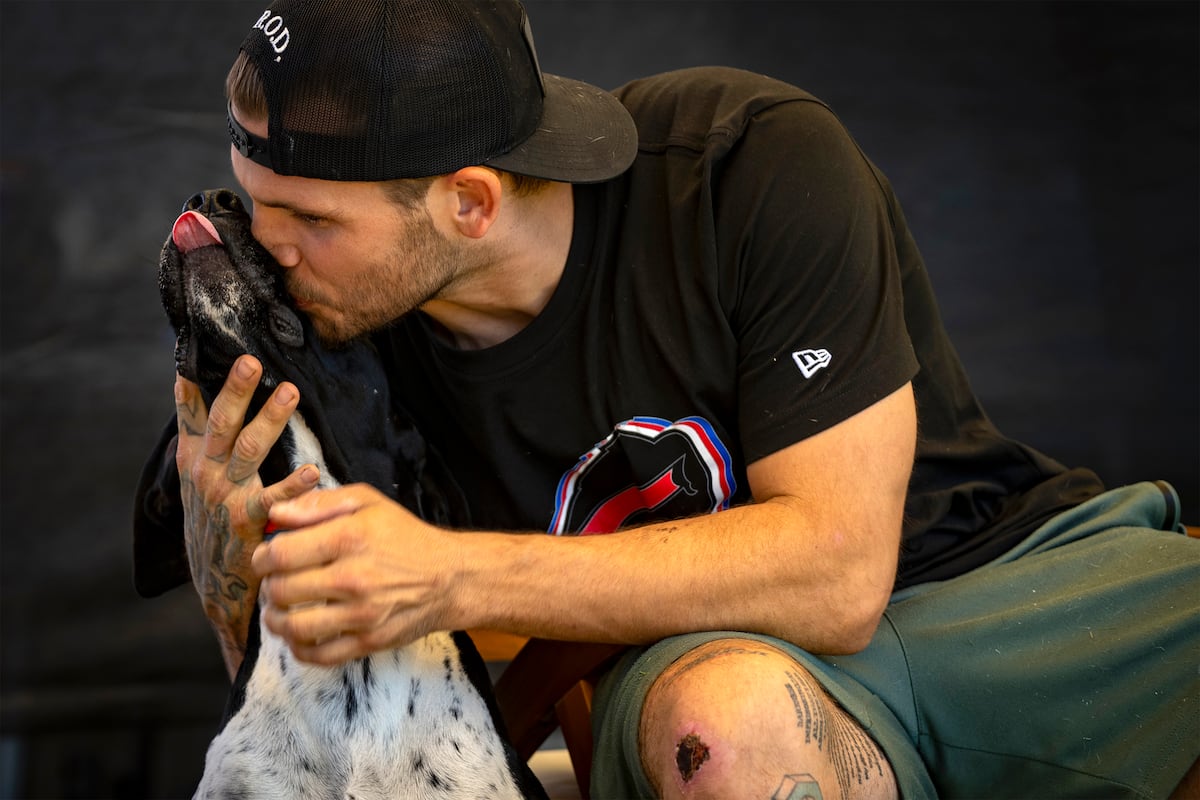Ogden • Jake Schmitt looked up, droplets from the cool stream dribbling down his chin, and locked eyes with his best friend, Buddy. The 6-year-old German shorthaired pointer also had water dripping from his black snout.
Schmitt, 34, has been a hunter for most of his life and a hunting guide in Utah for almost a decade. He knew he shouldn’t be drinking from a stream, that his stomach could violently cramp from giardia once the water and parasites worked their way inside. But that was a tomorrow problem. He wasn’t even sure he would make it through the night — or if he would even notice the pain with so much of it already wracking his body.
It had been hours — four? eight? Schmitt wasn’t sure — since his Polaris Ranger had tumbled down a hillside deep in the Uinta Mountains. In the rollover, he shattered both ankles, two ribs and his leg. By the time they reached the river, he and Buddy had been crawling down a rutted logging road, both on all fours, for so long that while the reinforced patches on the knees of Schmitt’s hunting pants remained intact, the skin on his kneecaps was shredded and bleeding. He needed this respite. He could see Buddy needed it, too.
“We looked at each other, and I was like, ‘Dude, this water is so good.’ And he was like, ‘Yeah, can we just take a minute? This water is really good,’” Schmitt recalled. “And I was like, ’We can take five minutes, Buddy. I’m so sorry.’”
Schmitt had gotten them into this — what would end up being an 11-hour slog to his truck and another 40-minute drive to help. What got them out, he said, was Buddy.
‘I had everything you could imagine’
Before he moved to Ogden in 2022, Schmitt made an annual pilgrimage from his home in Buffalo, N.Y., out West to Montana or Canada or Utah every August to subcontract for four months as a hunting guide. And he always brought Buddy, who had been Schmitt’s sidekick since he was 8 weeks old.
With another hunting season around the corner, the pair took a Sunday drive toward Whitney Reservoir, deep into the Uinta Mountains, to scout for big game. It was July 20, and the trip was going well. Schmitt had rescued an elk fawn from a bear trap and also spotted a large buck. Trying to get a better look at the buck, Schmitt steered his Ranger onto a trail about four miles into the forest that he said he’s “been on a million times.”
(Christopher Cherrington | The Salt Lake Tribune)
Quickly, though, he realized the trail had become unsafe over the winter. He decided to backtrack and shifted the Ranger into reverse. Before he even put his foot on the accelerator, Schmitt felt the back end start to slip down the incline.
“I knew it was going to flip, and I tried to jump out,” Schmitt said. “And upon trying to jump out, it started to roll, and it took my body with it.”
Schmitt believes the machine rolled over him twice before it spit him out a quarter of the way down the steep hill. It rolled about 15 more times before coming to a rest in a heap in a dry creek bed. The frame was contorted. The roof had been ripped off. The tires were flung dozens of feet away.
Buddy had been inside a crate in the back of the Ranger. The crate was nowhere to be seen. But there Buddy was, standing in front of Schmitt, wagging his stubby tail, not a scratch on him.
Schmitt hadn’t been so fortunate.
Courtesy of Jake Schmitt
Jake Schmitt moved to Ogden, Utah three years ago to work as a hunting guide. He got his dog, a German shorthair pointer he named Buddy, as a puppy six years ago. The dog stuck by him throughout the 11 hours it took him to crawl from the high Uintas to his truck after he broke his leg and both ankles when his Polaris Ranger slid down a hill.
He didn’t know the extent of his injuries, but when he put weight on his right leg to stand, his ankle popped and he collapsed back to the ground. Then he looked at his left leg and couldn’t comprehend what he was seeing: His foot was folded back and his lower leg was skewed at a strange angle.
Even on healthy legs, it would have been difficult to stand on the incline. In his state, it would be impossible. So, Schmitt opted to roll down to the wreckage instead. Along the way, he hoped he would spot his satellite phone, or his radio or his cellphone, or at very least the gun he carried to scare away bears — anything he could use to signal for help.
“I had everything you could imagine,” he said. “But it doesn’t matter when it just gets flung off of you.”
The one usable thing he found? A small roll of duct tape. Through the tumult, it remained stuck inside the Ranger’s center console.
Schmitt sized up his situation: “I have no communication. I’m screwed. I’m going to have to drag myself out, as painful as that is.”
First, though, he had to set his broken leg.
The breaks
Schmitt wasn’t just some tourist lost in the woods. His years of guiding and backcountry exploration had left him uniquely qualified to deal with his perilous predicament.
He was so familiar with the old road that he knew he had to make six stream crossings before he would reach his truck. He knew to drink only from the most rapidly moving sections of those streams to mitigate the chances of contracting giardia. And, he had experience with self-administered wilderness first aid.
“If you don’t know how to literally drag yourself out at the end of the day, then probably don’t go out there,” Schmitt said, “because you’re going to die.”
Schmitt knew he needed to survive, even if only to make sure Buddy made it out alive. He found a straight piece of metal that had broken off the Ranger, scooted over to it and set his broken leg on top of it. Then, he pulled.
“I was way more scared to lose my leg than to rebreak that back,” Schmitt said of his rationalization for putting himself through that pain. “I was terrified.”
Courtesy of Jake Schmitt
Jake Schmitt’s pants are in tatters and wrapped in duct tape after he crawled for 11 hours from the high Uintas to his truck after he broke his leg and both ankles when his Polaris Ranger slid down a hill. He used the tape, a stick and his belt to splint his leg.
He created a splint with a mostly straight and sturdy stick and affixed it to the side of his leg with his belt and, of course, the duct tape.
By then, the sun had begun to set. So Schmitt called Buddy over and switched on the walnut-sized light on his collar. With just a crescent moon overhead, it would be their only light source for the next 10 hours as they lurched through the dark forest.
Crawling through the night
It didn’t take long for the adrenaline to wear off. Shock, fatigue and disorientation took its place.
Schmitt started the long journey to his truck by scooching backward, using his arms to drag his body down the road. Later, spooked by animal sounds he heard in the forest, he turned onto his belly and, with a rock in each hand for protection against the gravel and the wildlife, began to crawl. His ankle flopped helplessly behind him, and he could feel the bone shards grinding against one another. Ahead of him, Buddy zigzagged back and forth, picking up scents on the wind.
Their progress was glacial. At the second stream crossing, Schmitt convinced himself it was the fifth one. When a bend in the road jogged his memory, Schmitt broke down; they still had so far to travel.
They stopped often. Sometimes sleep would overtake Schmitt, but he would always be jolted back awake by the sensation of Buddy’s black nose nudging his head. When Schmitt felt like he just couldn’t go on, Buddy would lie down on the road 20 feet ahead of him. Compelled by the dog’s forlorn look, Schmitt would find the energy to scoot over to comfort his friend.
“I would pet him, and then he’d go 20 feet more,” Schmitt recalled. “And now I know he was just helping me, step by step.”
(Rick Egan | The Salt Lake Tribune) Jacob Schmitt with his dog Buddy, at his home in Ogden, on Thursday, July 31, 2025.
When daylight broke the next morning, Schmitt called it the “worst sunrise I’ve ever seen in my entire life.” It meant he hadn’t been crawling for three or four hours, like he’d thought, but closer to 10. The adrenaline kicked in, though, when the sunlight illuminated his truck in the distance.
Thankfully, he’d left his keys inside it.
An unexpected visitor
Yenni Saiz was putting yard games out in front of the Oakley Diner, as the 19-year-old waitress usually does to prepare for the 8 a.m. breakfast crowd, when the mud-colored Toyota pulled up next to her. The man inside rolled down his window, and Saiz grew nervous.
“You can tell he was in pain,” said Saiz, a Weber State student and Oakley resident, “and he had scratches on his face. He had a dog in the back seat, too.”
(Christopher Cherrington | The Salt Lake Tribune)
Schmitt had driven his broken body and best friend more than half an hour to the diner, the nearest place he thought might be open so early. He asked Saiz to call 911 and relayed to her the details of his ordeal and his injuries. Four minutes later, paramedics were on the scene.
Schmitt was loaded into an ambulance bound for Park City Hospital. Buddy had to stay behind. But the Oakley Fire Station kept him until Schmitt’s mom flew in the next day from New York to collect him.
(Rick Egan | The Salt Lake Tribune) Jacob Schmitt with his mother Mel and his dog Buddy, at his home in Ogden, on Thursday, July 31, 2025.
Schmitt spent a week in the hospital while doctors inserted a rod in his broken leg and gave his ribs time to heal. On his final day, the nurses gave Schmitt’s mom, Mel Lenz, who is also a nurse, the go-ahead to bring Buddy to the hospital. The dog could barely be restrained from climbing into bed with Schmitt.
“He cried. I cried,” Schmitt said. “It was pretty wild.”
Both are back at home in Ogden now. Schmitt, who is uninsured, is trying to distract himself from his mounting medical bills by managing his welding fabrication company and committing himself to his physical therapy. His ambitious goal is to be guiding again by early September.
As for Buddy, he has all the bones — and all the cool, clean water — a dog could want. And, Schmitt said, he always will.
“He’s the little man that got me out of there for sure,” Schmitt said. “If he wasn’t there, I probably wouldn’t have made it mentally, spiritually.”
A GoFundMe has been set up to help Schmitt pay for medical expenses and loss of equipment. As of Wednesday, the fund had received more than $20,000 in donations.
Note to readers • This story is available to Salt Lake Tribune subscribers only. Thank you for supporting local journalism.
















